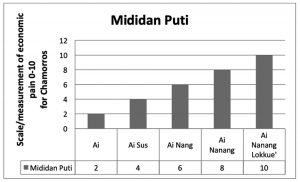Radio program models economic pain measurement
The Marianas Agupa Chamorro Radio Talk Show is pleased to release its scale/measurement of economic pain model, called “Mididan Puti” in the Chamorro language, for the Commonwealth of the Northern Mariana Islands.
This scale/measurement of economic pain is the product of many fine local people on Saipan, Tinian and Rota who have been actively participating in the Chamorro talk show program since 2009 on Magic 100.3 FM from 9am to 11am on Saturdays.
According to Glenn H. Manglona, the host of the Marianas Agupa Program, “the Mididan Puti” was the word coined by Thomas D. Mendiola, commonly known as “Guelu Fadang” who is our radio correspondent from Rota. During his weekly radio reports from Rota since 2009, he discussed issues of economic matters that directly affect the people on Rota, including not being able to buy the most essential things in life for survival like rice, milk and medicine because of air and ocean transportation delays and the cost of utilities and gasoline. The discussion centered on the way the people endured the hard living conditions for over 50 years. From not being able to find a job to being terminated from a job due to wrong political affiliation, and the list goes on and on.
During on air and personal conversations with Guelu’ Fadang, we found out that this can be something big and useful yet entertaining for our people if only we can come up with the elements that constitute a scale or measurement of the economic suffering our people are going through today. But without knowing where this will lead us, we decided to continue calling it the “Scale/Measurement of Economic Pain”, or “Mididan Puti” in Chamorro.
In the latter part of 2010, the late Leon Taisacan contributed the word “Ai Nanang Lokkue” as he described the day he will be in such economic pain if he were to lose his pension under the NMI Retirement Fund if the Fund went belly up. Former senator David Cing reaffirmed Taisacan’s description of the Retirement Fund’s doomsday on air on Marianas Agupa.
During one of the Marianas Agupa programs in 2011, former Rota mayor Joseph Inos commented on Taisacan’s assertion about “Ai Nanang Lokkue” in the scale/measurement of economic pain that there must be categories preceding the “Ai Nanang Lokkue,” and that is “those who are suffering less economic pain should be properly labeled as “Ai Nang” and “Ai Nanang,” respectively.
In the early part of 2012, as the host of the program, Glenn H. Manglona made a commitment to complete this scale of measurement. And so he began to review the audio recordings of the Marianas Agupa show on mp3 to see if he could connect the dots on the scale/measurement of economic pain and has found the missing links, “Ai” and “Ai Sus,” to be placed as the lowest level on the scale in the measurement of economic pain.
“But this was not complete until we listened and integrated ideas presented on Marianas Agupa by many of our listening audience in order to properly label the scale/measurement of economic pain,” said Manglona. “And so the show continues until today and many of our fine local people who participated during the talk show program, including Mr. John Del Rosario Jr., have made a huge contribution to the elements associated in their life experiences and living hardships and in determining the scale/measurement of economic pain in Chamorro. We thank you all for sharing the information and description of your life experiences.”
Factors
The preliminary model of scale/measurement of economic pain, called “Mididan Puti” in Chamorro, shows the factors in determining the measurement:
• 2010 Census Population of Indigenous Chamorros and Carolinians at 15,363.
• 44% of families in the CNMI were below the US Poverty level in 2009.
• 1314 Chamorro and Carolinian families were below the poverty level in 2009.
• The mean family income in 2009: $34,580.
• CUC rates including water and power rates.
• The Consumer price index in the CNMI.
• The Gross Domestic Product of the CNMI.
Sample
The scale/measurement of economic pain below is for a person with a family of four living in the Commonwealth of the Northern Mariana Islands, with a mean family income of $34,580.
Ai: This scale at level 2 indicates a person is living paycheck to paycheck with no savings and is barely making ends meet due to the high cost of housing, electricity, water, fuel, food, health insurance, telephone/cell phone/internet and car payments.
Ai Sus: Level 4 indicates a person who missed making payment for his/her monthly telephone/cell phone bill and got disconnected. Asking money from a family member or a relative.
Ai Nang: Level 6 indicates a person who got his phone reconnected but this time, his/her electricity got disconnected. Cancelled his/her health insurance. Puts only $10 gasoline in his/her car every two days.
Ai Nanang: Level 8 indicates a person who got both his/her home/cell phone and electricity disconnected at the same time. Missed his/her car payments for more than a month. Lost his/her job in the government for excessive absenteeism. Seeking assistance from his/her elected precinct representatives and senators.
Ai Nanang Lokkue’: Level 10 indicates that a person got his phone, electricity and water disconnected. But this time, missed the car payments for two consecutive months. Bank letter for auto repossession is received. Lost his/her job. Retirement pension is reduced. His/her party lost the election but pretended to be part of the winning party by showing up at winning party’s camp immediately after the election. (PR)







